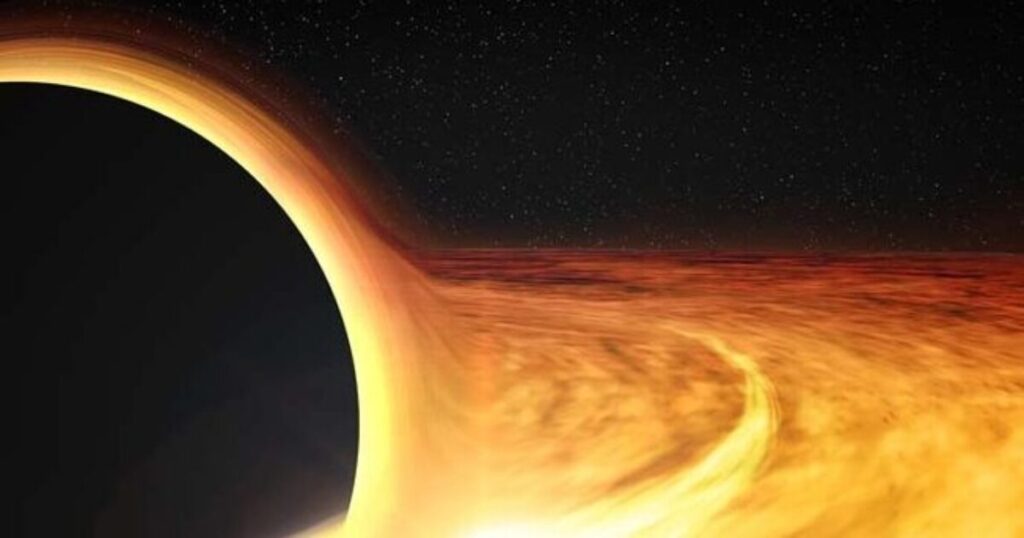On Nov. 22, 2014, astronomers noticed a unprecedented occasion withinside the night time sky: A supermassive black hollow on the middle of a galaxy, almost three hundred million light-years from Earth, ripping aside a passing supermegacelebrity. The occasion, referred to as a tidal disruption flare, for the black hollow’s large tidal pull that tears a celebrity aside, created a burst of X-ray pastime close to the middle of the galaxy. Since then, a bunch of observatories have skilled their attractions at the occasion, in hopes of gaining knowledge of greater approximately how black holes feed.
Now researchers at MIT and somewhere else have pored via statistics from more than one telescopes’ observations of the occasion, and located a apparently extreme, solid, and periodic pulse, or sign, of X-rays, throughout all datasets. The sign seems to emanate from a place very near the black hollow’s occasion horizon — the factor past which cloth is swallowed inescapably through the black hollow. The sign seems to periodically brighten and fade each 131 seconds, and persists over at the least 450 days.
The researchers consider that some thing is emitting the periodic sign need to be orbiting the black hollow, simply outdoor the occasion horizon, close to the Innermost Stable Circular Orbit, or ISCO — the smallest orbit wherein a particle can properly journey round a black hollow.
Given the sign’s solid proximity to the black hollow, and the black hollow’s mass, which researchers formerly anticipated to be approximately 1 million instances that of the sun, the group has calculated that the black hollow is spinning at approximately 50 percentage the rate of light.
The findings, suggested nowadays withinside the magazine Science, are the primary demonstration of a tidal disruption flare getting used to estimate a black hollow’s spin.
The study’s first author, Dheeraj Pasham, a postdoc in MIT’s Kavli Institute for Astrophysics and Space Research, says that maximum supermassive black holes are dormant and don’t generally emit a great deal withinside the manner of X-ray radiation. Only sometimes will they launch a burst of pastime, together with whilst stars get near sufficient for black holes to consume them. Now he says that, given the group’s results, such tidal disruption flares may be used to estimate the spin of supermassive black holes — a feature that has been, up till now, extraordinarily elaborate to pin down.
“Events in which black holes shred stars that come too near them should assist us map out the spins of numerous supermassive black holes which might be dormant and in any other case hidden on the facilities of galaxies,” Pasham says. “This should in the long run assist us apprehend how galaxies developed over cosmic time.”
Pasham’s co-authors consist of Ronald Remillard, Jeroen Homan, Deepto Chakrabarty, Frederick Baganoff, and James Steiner of MIT; Alessia Franchini on the University of Nevada; Chris Fragile of the College of Charleston; Nicholas Stone of Columbia University; Eric Coughlin of the University of California at Berkeley; and Nishanth Pasham, of Sunnyvale, California.
A actual sign
Theoretical fashions of tidal disruption flares display that once a black hollow shreds a celebrity aside, a number of that supermegacelebrity’s cloth can also additionally live outdoor the occasion horizon, circling, at the least temporarily, in a solid orbit together with the ISCO, and giving off periodic flashes of X-rays earlier than in the long run being fed through the black hollow. The periodicity of the X-ray flashes as a consequence encodes key data approximately the scale of the ISCO, which itself is dictated through how rapid the black hollow is spinning.
Pasham and his colleagues notion that if they may see such ordinary flashes very near a black hollow that had passed through a latest tidal disruption occasion, those alerts should supply them an concept of the way rapid the black hollow turned into spinning.
They targeted their seek on ASASSN-14li, the tidal disruption occasion that astronomers recognized in November 2014, the use of the ground-primarily based totally All-Sky Automated Survey for SuperNovae (ASASSN).
“This device is thrilling due to the fact we suppose it’s a poster infant for tidal disruption flares,” Pasham says. “This specific occasion appears to healthy among the theoretical predictions.”
The group seemed via archived datasets from 3 observatories that gathered X-ray measurements of the occasion considering its discovery: the European Space Agency’s XMM-Newton area observatory, and NASA’s area-primarily based totally Chandra and Swift observatories. Pasham formerly advanced a laptop code to locate periodic styles in astrophysical statistics, aleven though now no longer for tidal disruption activities specifically. He determined to use his code to the 3 datasets for ASASSN-14li, to peer if any not unusualplace periodic styles might upward thrust to the surface.
What he found turned into a quite strong, solid, and periodic burst of X-ray radiation that seemed to return back from very near the threshold of the black hollow. The sign pulsed each 131 seconds, over 450 days, and turned into extraordinarily extreme — approximately forty percentage above the black hollow’s common X-ray brightness.
“At first I didn’t consider it due to the fact the sign turned into so strong,” Pasham says. “But we noticed it in all 3 telescopes. So withinside the end, the sign turned into actual.”
Based at the residences of the sign, and the mass and length of the black hollow, the group anticipated that the black hollow is spinning at the least at 50 percentage the rate of light.
“That’s now no longer incredible rapid — there are different black holes with spins anticipated to be close to ninety nine percentage the rate of light,” Pasham says. “But that is the primary time we’re capable of use tidal disruption flares to constrain the spins of supermassive black holes.”
Illuminating the invisible
Once Pasham located the periodic sign, it turned into as much as the theorists at the group to locate an cause of what can also additionally have generated it. The group got here up with numerous scenarios, however the one which appears the maximum probably to generate the sort of strong, ordinary X-ray flare includes now no longer only a black hollow shredding a passing supermegacelebrity, however additionally a smaller kind of supermegacelebrity, referred to as a white dwarf, orbiting near the black hollow.
Such a white dwarf can also additionally had been circling the supermassive black hollow, at ISCO — the innermost solid round orbit — for a few time. Alone, it might now no longer had been sufficient to emit any form of detectable radiation. For all intents and purposes, the white dwarf might had been invisible to telescopes because it turned around the incredibly inactive, spinning black hollow.
Sometime round Nov. 22, 2014, a 2nd supermegacelebrity handed near sufficient to the device that the black hollow tore it aside in a tidal disruption flare that emitted an large quantity of X-ray radiation, withinside the shape of warm, shredded stellar cloth. As the black hollow pulled this cloth inward, a number of the stellar particles fell into the black hollow, even as a few remained simply outdoor, withinside the innermost solid orbit — the very identical orbit wherein the white dwarf turned around. As the white dwarf got here in touch with this warm stellar cloth, it probably dragged it alongside as a luminous overcoat of sorts, illuminating the white dwarf in an extreme quantity of X-rays whenever it turned around the black hollow, each 131 seconds.
The scientists admit that the sort of situation might be extraordinarily uncommon and might handiest ultimate for numerous hundred years at maximum — a blink of an eye fixed in cosmic scales. The possibilities of detecting the sort of situation might be relatively slim.
“The trouble with this situation is that, when you have a black hollow with a mass that’s 1 million instances that of the sun, and a white dwarf is circling it, then sooner or later over only a few hundred years, the white dwarf will plunge into the black hollow,” Pasham says. “We might’ve been extraordinarily fortunate to locate the sort of device. But at the least in phrases of the residences of the device, this situation appears to work.”
The results’ overarching importance is they display it’s far feasible to constrain the spin of a black hollow, from tidal disruption activities, consistent with Pasham. Going forward, he hopes to perceive comparable solid styles in different supermegacelebrity-shredding activities, from black holes that are living similarly lower back in area and time.
“In the subsequent decade, we are hoping to locate greater of those activities,” Pasham says. “Estimating spins of numerous black holes from the start of time to now might be precious in phrases of estimating whether or not there’s a dating among the spin and the age of black holes.”
This studies turned into supported, in part, through NASA.








More Stories
NASA’s Space Robots Work With Astronauts In International Space Station For The First Time
How Did Earth Become a Habitable Planet?
Why NASA’s Annoyed About Elon Musk’s Giant Rocket